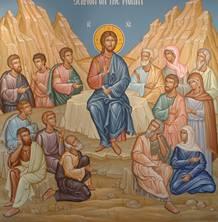Sermon on the Mount
SERMON ON THE MOUNT
 Objectives:
Objectives:
- Students should know that the Sermon on the Mount is full of teachings of Jesus.
- Students should be able to list several important teachings of Jesus: the light of the world, the salt of the earth, the sparrows and lilies, the house on the rock, seek ye first the Kingdom of God, etc.
- Students should memorize and be able to recite the Beatitudes.
Possible Lesson Plan:
- Open with prayer.
- Read the Sermon on the Mount in Matthew, chapters 5-7. All classes are working on the Beatitudes; each of the younger classes is focusing on a particular teaching. By this age, the students should be looking at an overview of the entire sermon. After reading, have students list several famous teachings – light of the world, salt of the earth, lilies and sparrows, houses on rock and sand, seek ye first the kingdom of God, etc.
The Church sees the Beatitudes as steps, each building on the ones before – beginning with humility, without which no further spiritual progress is possible – a ladder of virtues. Indeed, St. John Climacus, in his Ladder of Divine Ascent, often calls on the teachings of the Beatitudes.
- Begin to memorize the Beatitudes. Sing them as we do in liturgy.
- Note that the format of the Beatitudes, “Blessed are the…”, would be familiar to Jesus’s Jewish audience from the Psalms and the rest of the Old Testament. But, Jesus adds new meaning! Discuss the Beatitudes as you recite each one:
- Poor in Spirit: What is humility? How does it compare with the self-centered society we live in?
- Those who mourn: What causes US to mourn? Do we mourn over our sin, separating us from God? Are we drawn closer to God by the times when everything is going well or the times when we are mourning?
- The Meek: Do we have control over the passions, over anger? Are we equally at peace whether praised or dishonored by others? Think of Jesus before the Sanhedrin!
- Hunger and Thirst after Righteousness: Do we seek God and His will with all our heart? Do we fervently seek to find out His will and obey Him, the source of all righteousness?
- Merciful: Do we burn with love for all of God’s creatures, all of our fellow men, reflecting God’s divine love to all?
- Pure in Heart: We cannot produce a pure, or clean, heart by ourselves, but God must work in us. Our part of the job? Repentance!
- Peacemakers: Do we work to bring peace to the lives of those around us?
- Persecution: Jesus promises His followers that, if they follow His teachings, the world will not understand them, will speak evil against them. Are we happy members of the society around us? Or sojourners in a strange land, living the Christian life in a society less and less Christian?
- Discussion: Many of Jesus’s teachings in the Sermon on the Mount have to do with true discipleship – our singleness of purpose in seeking God’s kingdom. “Seek ye first the kingdom of God” comes to mind. How does the salt of the earth fit in? The light of the world? Serving God and Mammon (riches)? House built on the rock? Anxiety about the future? There are many distractions in our search for God’s kingdom. Have the students brainstorm some things they enjoy: TV, McDonalds, football, etc. Honestly consider: if choosing between these activities and going to church, reading the Bible, or saying prayers at home, which would win? Have we really given up all to follow Jesus?
- Play a learning game: “Match the Object”. Fill an egg carton with objects from the Sermon on the Mount – salt shaker, lightbulb, eye, shirt, coin, bread, bird (toy), grass or silk lily, pearl or pearl necklace, fruit, rock, sand – would be examples. Student selects blindly an object and should explain to the class how that object represents a teaching of Jesus in the Sermon on the Mount.
- Add to your time line as usual: Perhaps some of the objects from the “Match the Object” game could be incorporated.
- Close with prayer. Use the Lord’s Prayer, also from the Sermon on the Mount.